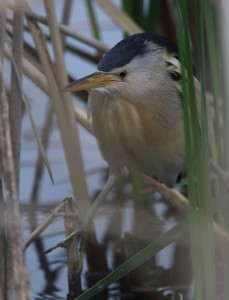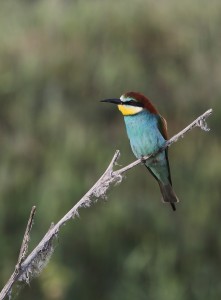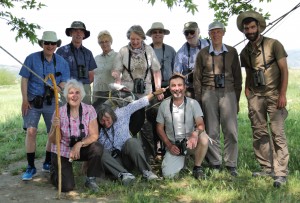A cloudy sky and light rain are not what we came to Greece for, but the rich birdlife soon makes up for the weather. A Little Owl poses on a heap of old tyres on the outskirts of our village (Hrisohorafa), while Hooded Crows stalk the short grass. Within minutes of leaving the hotel, we are following a drainage canal, alive with croaking Great Reed Warblers, and it doesn’t take our local guide George long to find us a male Little Bittern sitting ‘invisibly’ in the reeds barely five yards away! There seem to be birds singing everywhere, with vociferous Bee-eaters, Hoopoes, Cetti’s and Olivaceous Warblers, Nightingales and Cuckoos galore, making a wonderful soundtrack, accompanied by a succession of quality sightings including White Stork, Syrian Woodpecker, Crested Lark, black-headed Yellow Wagtail, Red-backed Shrike and Spanish Sparrow, while several Cuckoos chase each other back and forth, stopping briefly to call from a dead tree right above us, as if too busy to worry about their audience, providing some fantastic ‘footage’. Even more remarkably, a female Golden Oriole makes repeated sorties from the nearby stand of Poplars to ‘see off’ a pair of amorous Cuckoos in a thrilling aerial chase! From the same spot we also stake out the nest of Penduline Tits, darting in and out, while rival Nightingales tussle in the dense bushes around the nest. By now it is almost lunch time and yet we have barely covered any distance at all thanks to the amount of action this morning. During our picnic lunch, a Black Kite floats by, a Purple Heron poses further along our bank and eleven Turtle Doves line up on a wire in the same scope view! After lunch, we scope more Bee-eaters, this time perched against a back drop of blood red Poppies, followed by scope views of a statuesque female Little Bittern, in the same ditch as a Night Heron and two Pygmy Cormorants. Moving on along the eastern shore of Lake Kerkini, we stop for an awesome raft of at least five thousand Great Cormorants! I have never seen so many in one place. Amongst the throng are a couple of dozen scruffy looking Dalmatian Pelicans and one well groomed White Pelican, flushed with a lovely pink wash. On the landward side of the track, we stop for a female Green Woodpecker with a black moustache, stunning scope views of a posing rufous phase female Cuckoo, and another Penduline Tit nest, but this time it is still being built, and it quivers as we watch the black-masked male regularly pop his head out while working on the intricately woven woolly nest, which appears to be tied to the end of a twig with string! It’s now late afternoon and we are still seeing new birds such as Squacco Heron, Black-winged Stilt, Mediterranean Gull, Great White Egret, Spoonbill and Wood Sandpiper, as well as a large aquatic rodent known as a Coypu. What a fabulous first day, with so many memorable experiences. In fact I don’t think I have ever heard so many Nightingales, which seem to sing from every available clump of bushes, and are even audible inside the hotel dining room!

It’s 1st May and a public holiday in Greece, and as we stroll along the tranquil Xiropotomos valley, it soon becomes apparent from the steady stream of pickup trucks heading up the track, laden with dozens and dozens of plastic chairs, that the entire village is intent on finding a nice quiet spot up in the hills to throw a massive party, although I wonder where they will all find space to park. One truck even has a smoking barbecue in the back! Despite the traffic, the ubiquitous Nightingales continue to sing, along with Corn and Cirl Buntings, and Olivaceous and Subalpine Warblers, while other sightings include more Turtle Doves and Crested Larks, plus Whinchat, Masked and Woodchat Shrikes, Jay, Lesser Spotted Eagle, a pale phase Booted Eagle, two really smart male Black-eared Wheatears of the dark-throated form, and a couple of Ravens heading for the barbecue! From here we follow the west shore of the lake where we find Levant Sparrowhawk, with diagnostic pointed black wingtips, Greenshank and an aberrant Wood Sandpiper with orange legs! By now it’s time for a picnic, with plum views of a Short-toed Eagle circling against the hillside, as well as another Lesser Spotted Eagle, soaring White and Dalmatian Pelicans and nearby Red-backed, Woodchat and Masked Shrikes, plus Hermann’s and Spur-thighed Tortoises! Moving on, through villages lined with nesting White Storks, up into the hills above Vironia, we spot Hobby and both male and female Marsh Harriers soaring above a wooded peak, as well as our target Golden Eagle, gliding in circles with a tortoise in its talons, before heading north across the ridge towards Bulgaria! Other great sightings here include a Dung Beetle busily pushing a perfectly spherical pellet of dung round in circles, an incredibly well camouflaged Preying Mantis, with a body like a leaf stalk, and a stunning iridescent blue White Admiral. This was one of many lovely butterflies seen today including Clouded Yellow, Green Hairstreak, Red Admiral, Brimstone, Southern Marbled Skipper, Eastern Festoon, Queen of Spain Fritillary and Scarce Swallowtail. Back on the flood plain below Vironia, a stroll through the riverine woods adds Spotted Flycatcher and Kingfisher to the ever growing list of sightings, as well as a beautifully patterned Horn-nosed Viper, on the track which John almost treads on before it slithers back into the adjacent grass. On the way back to our village, a brief ‘off piste safari’ alongside the Strimonas River brings us into close contact with a fall of ashy-headed Yellow wagtails, a Hoopoe and more beautiful Bee-eaters, while a newly arrived Roller completes our collection of ‘the big four’; Hoopoe, Bee-eater, Golden Oriole and Roller. By now it’s almost time for dinner but we have to make an emergency stop for three pairs of Red-footed Falcons, sitting on the roadside wires with others in the adjacent field. With the evening light behind us these handsome falcons with orange eye rings and ceres to match their feet look superb, and as the sexes are so different, there is an inevitable beauty contest between the slate grey males, and the females, with their steel blue backs, ginger fronts and black mascara eyes. Personally, I prefer the ladies. This evening, over dinner, the snake grows in length with each swig of beer, and transforms from a painfully poisonous two foot viper into a deadly venomous twelve foot man-eating python, which had John by the throat as it coiled itself around him, before he wrestled himself free from his potentially lethal encounter with the vicious serpent!

It’s a beautiful sunny day as we follow the road to Drama! Journey’s end is Mount Paggaio, a 6520 foot peak, still scantily clad in the remnants of last winter’s snow. At the foot of the mountain the village of Eleftheroupoli is home to Pallid Swifts, showing really nicely against the deep blue sky. Ascending through a range of vegetation zones, the ubiquitous Nightingales are replaced by Chaffinches and Robins and at one stop we find a very large Spur-thighed Tortoise, which has been through the wars, with an old healed crack in its shell as though it has survived being dropped from a great height by a Golden Eagle! At the tree line we find droppings packed with coarse dark fur, confidently identified by George as the scat of a Wolf which had feasted on Wild Boar, and above the tree line we spot Tree and Tawny Pipits, Black Redstart, Stonechat, Northern Wheatear, Linnet, Ortolan Bunting and two magnificent male Rock Thrushes duelling with repeated aerial song flights, while Ravens and Alpine Choughs soar high above the summit. After a picnic lunch amidst spectacular mountain scenery, we scope a superbly marked male Rock Bunting. At the end of the quiet road is a deserted ski resort, where we find Marsh Tit and Great Snipe!
The weather now seems to have settled into the typical Mediterranean pattern as we head west for Lake Artzan, but first we have to stop for seven Black Storks feeding below the dam at Lithopotomos. Further on we make an emergency stop for a Tawny Owl, perfectly framed in an open window on the side of a derelict house and then stroll through a tranquil riverine wood, with a deafening cacophony of ‘singing’ Marsh Frogs, as well as Green and Middle Spotted Woodpeckers, Nuthatch and a stunningly iridescent indigo Beautiful Demoiselle which fills the scope, while resting on a leaf just ten yards away. Further west we reach a landscape of open, rolling meadows and rocky outcrops, and enjoy excellent views of numerous singing Calandra Larks and Black-headed and Corn Buntings, as well as a fabulous male Montagu’s Harrier, patrolling to and fro at close range. A vivid orange Tiger Moth is another notable sighting here before we arrive at the lake, where we find an Osprey eating a fish on a post and count at least thirty-five Ferruginous Ducks, looking resplendent in the sunshine with their burnished copper sheen. A Cuckoo shoots by as we watch another male Penduline Tit busily mould its hanging nest, neatly woven from Tamarisk ‘fluff’. Back on the lake, there are numerous Pygmy Cormorants, Common Terns, a couple of Little Terns and Garganey, and a Great White Egret, as well as four Ruff, four Black-winged Stilts, four Spoonbills and four Glossy Ibises, showing their lovely bronze sheen in the sunshine. Meanwhile a passing Long-legged Buzzard, harried by a Hooded Crow, does a complete roll to fend off the ‘Hoodie’ with its talons, and we find a Tawny Pipit amongst another fall of ashy-headed Yellow Wagtails. Returning to Lake Kerkini, we stop to help a couple of Hermann’s Tortoises safely cross the road and savour the gentle early evening light, illuminating the many Great Crested Grebes, Grey Herons, Little Egrets, and a Dalmatian Pelican, with a deep yellow throat pouch, on the mirror calm lake, as a myriad pieces of white Poplar fluff drift gently downwards, like a fall of giant snowflakes. Thanks to this photo-opportunity we also find a posing Lesser Grey Shrike, making seventy-six different birds seen today.
It’s yet another lovely sunny day as we head for Sidirokastro, where target birds include Crag Martin, Blue Rock Thrush and Western Rock Nuthatch. By 9.30am we have found and scoped two wonderfully blue male Blue Rock Thrushes, along with a browner female, at the Vizantino Kastro castle ruins. Other sightings here include soaring Long-legged Buzzard and Levant Sparrowhawk, Red-rumped Swallows, Black-eared Wheatear and Serin. Back in the town below the old castle, a stake out of a vertical wall of rock produces another Blue Rock Thrush, adeptly hanging on to the cliff, and eventually, a pair of Rock Nuthatches making the finishing touches to their nest ‘cemented’ to the cliff face. Meanwhile, along the river, we spot a couple of Crag Martins amongst hundreds of House Martins busy collecting mud for their nests, along with Grey and White Wagtails and a pair of Little Ringed Plovers. Heading up the valley above Sidirokastro, we enjoy a picnic lunch at a magnificent viewpoint, with snow patches on the distant peaks, while watching Golden Orioles flitting between the Poplars in the valley below, as well as Masked Shrike, Cirl Bunting and a pale-throated Black-eared Wheatear in the adjacent bushes. Alpine Swifts and a Hawfinch fly by and a Hummingbird Hawk Moth sips nectar from the wild flowers here. Higher up the valley, we stroll along a clear flowing stream, reminiscent of a typical Derbyshire river, complete with Dipper and lovely Bee Orchids, although the singing Golden Oriole, the three foot Four-lined Snake, the vivid Green Lizard and two Hermann’s Tortoises, one of which is small enough to rest on my fingertips, are a reminder that this is not Derbyshire! We return to Lake Kerkini for a late afternoon boat trip to parts that cannot be seen from the shore. This ‘unseen world’ is alive with thousands of nesting Great Cormorants, hundreds of White and Dalmatian Pelicans, and loads of Pygmy Cormorants, Little Egrets, Grey, Squacco and Night Herons and Spoonbills, while I have never seen so many Great Crested Grebes in one place! Way out on the lake we also find an immature Little Gull, a pair of Mediterranean Gulls, three Black-necked Grebes, a few Whiskered Terns, and one or two White-winged Terns amongst at least two dozen Black Terns. Back on dry land, a Kingfisher posing in the scope looks resplendent in the low early evening light, bringing the bird tally for the day to an amazing seventy-six species yet again!

This is our last day and as we still haven’t seen Sombre Tit, finding this local speciality is our number one goal this morning. A second visit to the Xiropotomos valley soon produces more stunning views of Black-headed Bunting, Black-eared Wheatear and Woodchat Shrike, all at close range, as well as a couple more lumbering Hermann’s Tortoises, while a Sardinian Warbler singing in full view is also added to the trip list here. After strolling for well over an hour, listening to the songs of so many Nightingales, as well as Golden Orioles and Cirl Buntings, we are just about to turn back when our target Sombre Tit emerges from the shrubbery, calling right in front of us! What fantastic timing. Back at the van, a pale phase Booted Eagle floats over at low level, while a soaring mixed flock of around thirty White and Dalmatian Pelicans circles overhead, making a fitting farewell to Lake Kerkini National Park.
Down at the coast, the Kalohori lagoons are peppered with Curlew Sandpipers coming into their brick red breeding plumage, alongside numerous Little Stints and Ruff, as well as a few Dunlin, Turnstones, Avocets, Ringed and Kentish Plovers, a Spotted Redshank in charcoal breeding plumage, and some Little Terns and Mediterranean and Slender-billed Gulls. Other notable sightings here include hundreds of Greater Flamingos, a superb male Yellow Wagtail of the local black-headed race displaying to his partner, and several ground squirrels known locally as Sousliks. It’s almost time to leave for the airport before one last scan across a dry area of saltmarsh, reveals a couple of Stone Curlews, with bright yellow eyes, matching their beaks and long legs; well spotted David. What fantastic timing again. As we watch in the scope a third bird emerges and the trio proceed to display to one another on tip toes with bowed heads, making a wonderful finale to a hugely successful trip to this quiet corner of northern Greece.
By now we had seen a variety of beautiful landscapes, awash with Poppies and other wildflowers, as well as a profusion of gorgeous butterflies, with some memorable reptilian encounters. The bird list alone came to 158 species, without any hard work, including both the Pelicans, three species of Sparrow, four different Shrikes, five types of Tern, six Buntings and four types of Eagle amongst fifteen different raptors, with the superb views of Red-footed Falcons voted bird of the trip by most of the group, followed by the nest-weaving Penduline Tits in second place. A big thanks to George for his excellent guidance once again.

